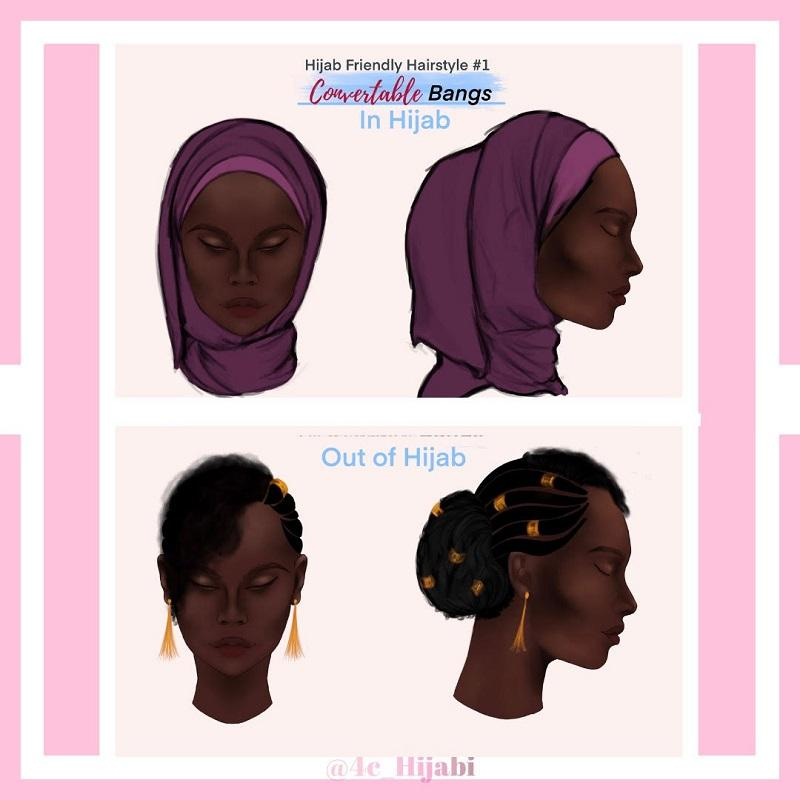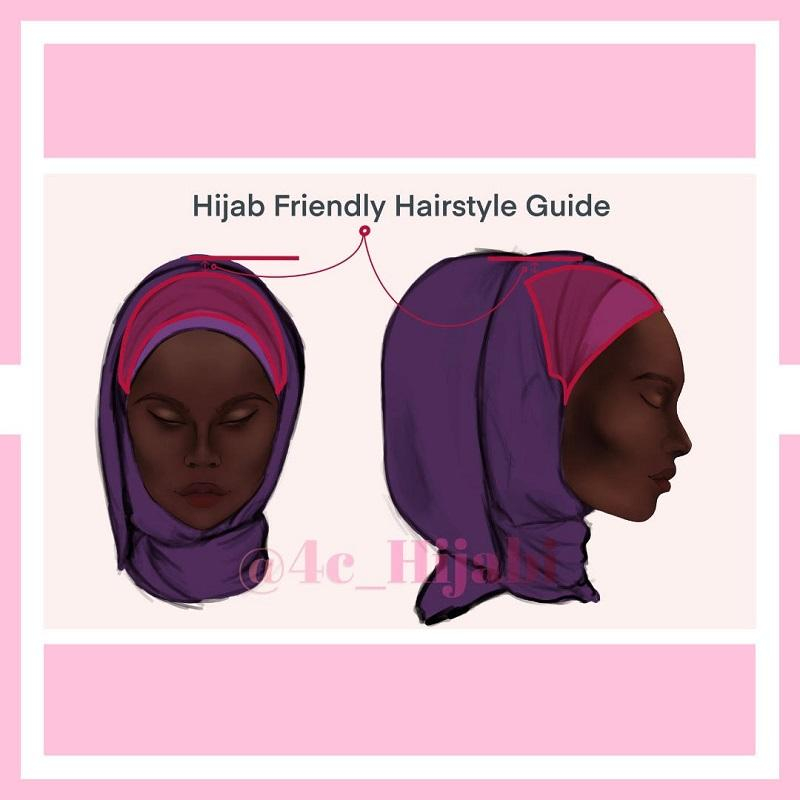Caring for Natural Hair While Wearing Hijab – an Interview with IG's 4c Hijabi!
Lifestyle
|
Oct 11, 2019
|
7 MIN READ

By Layla Abdullah-Poulos
The natural hair movement in the early 2000s influenced African American women across the country to embrace their hair. Previously denigrated, the popularity of twists, braids, locks and afros among Black women grew, as well as tutorials and products to help protect and maintain soft, coily tendrils.
Many African American and Black Muslim women have turned away from tools and chemical process that change their hair texture to conform to Eurocentric beauty standards. Hair straightening can burn the scalp and cause irreparable damage, requiring a “big chop” to return strands to their natural state. Natural hair, however, needs a lot of care. Additionally, wearing hijab can present challenges for covering women’s delicate hair. Alhamudlillah, the 4c Hijabi dedicates an Instagram page to help women care for their hair while wearing hijab.

4c Hijabi, as she is known on her Instagram page.
RS (aka 4c Hijabi) is a natural hair enthusiast with a strong background in mathematical education and digital art. She noticed a huge gap in the natural community while discussing hair challenges with fellow hijabis. After much research, reflection, trial and error, RS started to develop techniques and styles that catered to the lifestyle and religious needs of Black Muslim women. She opened the @4c_hijabi Instagram page to provide a space for Muslims women to share and learn from each other. RS wants to show other hijabis, particularly hair type 4 sisters, that it is very possible to comfortably love, maintain and care for our Afro textured hair under the hijab.
I spoke with RS to learn her perspective about natural hair care. She also shares some tips for Black Muslim women in loving and caring for their coils, braids and locks.
How important is it for Black Muslim women to take care of their natural hair?
Bismillahi Rahmani Raheem. First, I would like to answer this question as it relates to Muslims in general, then I will specify how it relates to Black Muslimahs.
As Muslims, it is a duty on us to take care of whatever Allah has blessed us with to the best of our abilities. Hair is no different, as Rasullullah is narrated to have said, “He who has hair should honor it." (Sunan Abi Dawud Book 35, Hadith 5) So if something as little as hair should be honored, it can be gathered that Allah makes no mistakes in emphasizing that we should love and take care of ourselves both internally and externally.
As Black Muslimahs, there is a greater need with regards to our hair. We need to perfect our hair routines because, in many nations, a colonialist mentality has erased a lot of our healthy hair care practices and beauty standards. While women of other races were able to retain their practices and adapt it for their head coverings, many Black Muslimahs with type 4c hair are still learning how to take care of their own hair. All of this while balancing our hijab against the push to conform to Eurocentric ideals.
So, it is doubly important that we work on caring for our natural hair and creating routines that work for us as Black women while catering to our religious obligations – wudu (abulation), ghusl (ritual cleansing) and hijab (for the sisters who cover).

What kind of hair damage can Black women experience from wearing a hijab?
There are many ways hijabs can be used to prevent damage, but there are several things all hijabis should be aware of. Hijab-specific hair damage can be caused by many factors. The most common that I have come across are the following:
1. Losing edges due to constantly wearing tight buns or buns in general. The edges or middle/crown of the hair can be affected by so much tension that it becomes very sensitive and sometimes painful to the touch.
2. Losing moisture due to the material of the undercaps. For example cotton, polyester, velvet or any fabric that is absorbent [is rough on our hair]. The loss of moisture makes hair prone to breakage. These materials also cause a lot of friction, which makes dry hair very prone to split ends, breakage, and in some cases, hair loss.
3. Scalp issues due to not washing hijabs and undercaps regularly. How many of us have spent hours on our hair during 'wash day? Then before we leave the house, we reach for the same undercap/hijab we have been wearing for days WITHOUT washing, only to start itching our heads under the hijab not long after and wondering if the shampoo was even effective? Clean hair should be coupled with freshly cleaned hijabs and undercaps.
4. The before and after ghusl/wudu hair care. How are you managing your hair before and after ghusl? Many make the mistake of thinking water alone is enough as a moisturizer. Unfortunately, the truth is, water is a hydrator. It hydrates the hair BUT it also evaporates, leaving the hair even drier and more brittle than before. For dryness-prone hair, this is a recipe for disaster. To retain moisture, use a good moisturizer when the hair is slightly damp or dry (not dripping wet) and SEAL it with an oil. If you have not found a suitable moisturizer yet, then seal your hydration with an oil.
How can women avoid damaging their natural hair?
This is a very broad question, as damage can be caused by various external (heat, weather, hair dyes, products, combs, etc.) and internal factors (vitamin deficiencies, genetics, hormones, etc.). Each case can vary from one person to the other. My main advice would be to treat things individually rather than looking for a quick fix on YouTube. It's like a doctor prescribing the same medicine to all their patients and not bothering to find out what the diagnosis is. We can all agree that this will only lead to disaster.
Therefore, it's important to truly pay attention to your own hair. Try to find out if the damage is external or internal and pinpoint why it is happening first. When you know the why you can then search for remedies and act according to fix the problem. Seeking professional help and advice is the quickest and recommended way to do this, especially if you are struggling to handle it on your own.

Illustration from 4c Hijabi's IG page about protective hairstyles for Black Muslim women who wear hijab.
What are the best hijab-friendly protective hairstyles for Black Muslim women?
This is an area that is still developing, and one I hope to showcase on @4c_Hijabi once I can get some hair models to demonstrate tutorials online. But I will give you my top two tips: A general rule for protection and a general rule for hijab friendly styles:
1. General rule for protective styles: Protective styles should protect the ends of the hair and protect the health of the scalp by NOT pulling on the strands to the point where there is pain of any kind.
When installed properly, twists, cornrows and locs are great styles because they protect the ends and do a good job of locking in the moisture you put in while installing the style. This is particularly useful for sisters who perform ghusl on a regular basis, as less moisture will be lost. They also last longer because they are better at withstanding the effects of wudu in comparison to styles like and blowouts and sleek buns.
2. A general rule for hijab-friendly styles: After much observation, I came to the conclusion that any hairstyle where the front half of the hair lies flat can be considered hijab-friendly. It avoids grey areas, like the infamous “camel hump,” and is a good base for coming up with your own hijab-friendly styles to suit your routine. (See the illustration above.)
Is there a way for women wearing braids to cover without their hijabs looking bumpy?
If you mean single strand braids, these are bumpy by nature. The best thing to do is to keep them smaller at the front half if possible. (Refer back to the previous answer)If you mean cornrows, the solution is to ensure the cornrows are close together so that the hijab fabric cannot dip between the gaps. The best way to reduce the size of the gap between cornrows is to part smaller sections. So let's say you do 10 cornrows usually, and there are bumps through the hijab. The solution would be to do about 15 cornrows or more depending on the size and shape of your head.

Illustration from 4c Hijabi's IG page about fabrics that are better for natural hair.
What fabrics are best for natural Black hair?
You should try to use satin/silk fabrics for undercaps. Or at least line your undercaps with satin/silk strips of fabric around the edges to reduce friction. This is also something I will be demonstrating on my page once I can get a model for tutorials
Satin and silk are slippery fabrics that reduce friction on the hair. Weak ends will be protected from damage caused by friction like split ends and breakage.
Learning to care for your hair can be a struggle because there is so much information out there and very few, if any, that focuses on hijab hair care. I only hope that this article and my page gives you an idea of where to start and how to achieve your hair goals.
But with anything please remember to put your deen first. Create a hair routine that fits in with your deen. Never compromise this for anyone or anything.
Subscribe to be the first to know about new product releases, styling ideas and more.
What products are you interested in?

